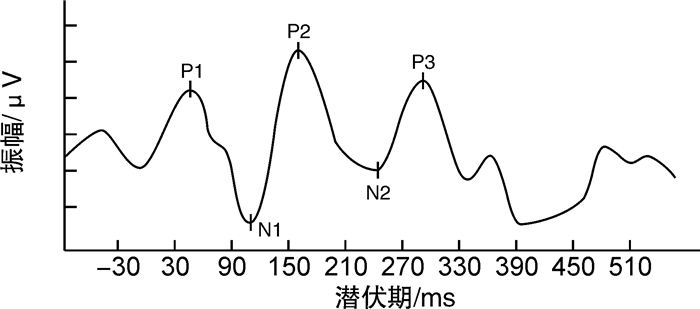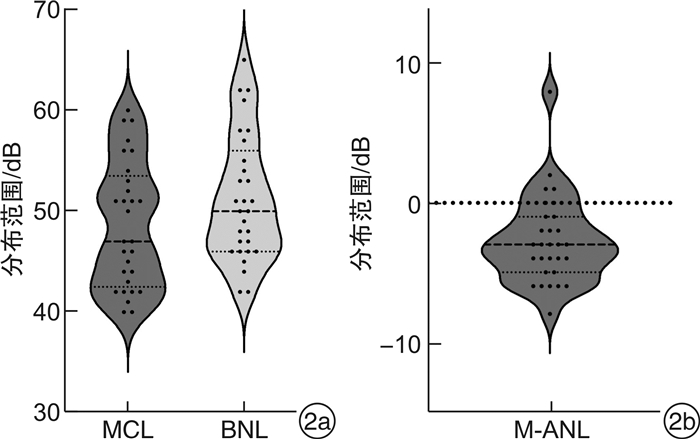Correlation between Mandarin acceptable noise level and cortical auditory evoked potential in young normal-hearing listeners
-
摘要: 目的 研究普通话可接受噪声级(M-ANL)与皮层听觉诱发电位(CAEP)的相关性,探讨导致M-ANL值个体化差异的可能机制。方法 选取30例22~33岁听力正常青年人作为研究对象,分别进行M-ANL测试和CAEP测试,记录每位受试者的最舒适阈(MCL)值、最大背景噪声级(BNL)值、M-ANL值及CAEP中P1、N1、P2、N2、P300各波的潜伏期及P1-N1、P2-N2、P300的幅值。采用SPSS 25.0软件进行统计分析,探讨MCL值、BNL值及M-ANL值与CAEP各波潜伏期及P1-N1、P2-N2、P300幅值之间的相关性。结果 ① MCL值和M-ANL值与CAEP的P2潜伏期均呈正相关,相关系数分别为0.404和0.400,差异均有统计学意义(P < 0.05);与CAEP的P1、N1、N2、P300潜伏期均无相关性(P>0.05)。② MCL、BNL及M-ANL值与CAEP的P1-N1、P2-N2及P300幅值均无相关性(P>0.05)。结论 听力正常青年人M-ANL与CAEP存在一定的相关性,提示中枢听觉皮层在听力正常个体背景噪声耐受能力方面可能发挥一定的调节作用。背景噪声接受能力更强的个体或许存在更强的中枢传出机制和/或更不活跃的中枢传入机制。Abstract: Objective To investigate the correlation between Mandarin acceptable noise level (M-ANL) and cortical auditory evoked potential (CAEP), and to explore the possible mechanism leading to individual differences in M-ANL values.Methods Thirty listeners aged 22-33 years with normal hearing were selected as the study subjects, and the M-ANL test and CAEP test were performed respectively. The most comfortable level (MCL), maximum background noise level (BNL), M-ANL and CAEP values of each subject were recorded. The latency of each wave of P1, N1, P2, N2, P300 and the amplitude of P1-N1, P2-N2, P300 in CAEP were recorded for each subject. SPSS 25.0 was used for statistical analysis to explore the correlation between the MCL value, BNL value and M-ANL values and the latency of P1, N1, P2, N2, P300 and P1-N1, P2-N2, P300 amplitudes of CAEP.Results ① The MCL value and M-ANL value were positively correlated with the P2 latency of CAEP, and the correlation coefficients were 0.404 and 0.400, respectively, and the differences were statistically significant (P < 0.05). There was no correlation with P1, N1, N2, and P300 latencies of CAEP (P>0.05). ②The MCL value, BNL value and M-ANL value had no significant difference with the CAEP wave amplitudes of P1-N1, P2-N2, and P300 (P>0.05).Conclusion There was a certain correlation between M-ANL and CAEP in young adults with normal hearing, suggesting that the central auditory cortex might play a potential regulatory role in the background noise tolerance. Individuals with a greater background noise acceptance might have stronger central efferent mechanisms and/or less active central afferent mechanisms.
-

-
表 1 听力正常青年人MCL值、BNL值及M-ANL值与CAEP各波潜伏期的相关性分析
MCL BNL M-ANL P1 N1 P2 N2 P300 MCL 1.000 BNL 0.853b) 1.000 M-ANL 0.176 -0.300 1.000 P1 0.016 0.080 -0.062 1.000 N1 -0.056 -0.137 0.201 0.635b) 1.000 P2 0.404a) 0.246 0.400a) -0.095 0.228 1.000 N2 -0.007 -0.102 0.312 0.039 0.386a) 0.255 1.000 P300 0.086 -0.059 0.309 0.045 0.290 0.122 0.810b) 1.000 注:a)在0.05级别(双尾),相关性显著;b)在0.01级别(双尾),相关性显著。 表 2 听力正常青年人MCL值、BNL值及M-ANL值与CAEP各波幅值的相关性分析
MCL BNL M-ANL P1-N1 P2-N2 P300 MCL 1 BNL 0.879b) 1 M-ANL 0.172 -0.315 1 P1-N1 0.226 0.217 0.005 1 P2-N2 0.170 0.235 -0.165 0.370a) 1 P300 -0.283 -0.265 -0.050 -0.099 0.227 1 注:a)在0.05级别(双尾),相关性显著;b)在0.01级别(双尾),相关性显著。 -
[1] Nabelek AK, Tucker FM, Letowski TR. Toleration of background noises: relationship with patterns of hearing aid use by elderly persons[J]. J Speech Hear Res, 1991, 34(3): 679-685. doi: 10.1044/jshr.3403.679
[2] Chen J, Zhang H, Plyler PN, et al. Development and evaluation of the Mandarin speech signal content on the acceptable noise level test in listeners with normal hearing in mainland China[J]. Int J Audiol, 2011, 50(6): 354-360. doi: 10.3109/14992027.2011.555735
[3] Nabelek AK, Freyaldenhoven MC, Tampas JW, et al. Acceptable noise level as a predictor of hearing aid use[J]. J Am Acad Audiol, 2006, 17(9): 626-639. doi: 10.3766/jaaa.17.9.2
[4] Jamos AM, Hosier B, Davis S, et al. The Role of the Medial Olivocochlear Reflex in Acceptable Noise Level in Adults[J]. J Am Acad Audiol, 2021, 32(3): 137-143. doi: 10.1055/s-0040-1718705
[5] Plyler PN, Madix SG, Thelin JW, et al. Contribution of high-frequency information to the acceptance of background noise in listeners with normal and impaired hearing[J]. Am J Audiol, 2007, 16(2): 149-156. doi: 10.1044/1059-0889(2007/019)
[6] Hedrick M, Stigers A, Grayless B, et al. Cognitive Measures and the Acceptable Noise Level[J]. Am J Audiol, 2021, 30(4): 1120-1129. doi: 10.1044/2021_AJA-20-00162
[7] Jonas Brännström K, Olsen SØ. The Acceptable Noise Level and the Pure-Tone Audiogram[J]. Am J Audiol, 2017, 26(1): 80-87. doi: 10.1044/2016_AJA-16-0033
[8] Plyler PN, Alworth LN, Rossini TP, et al. Effects of speech signal content and speaker gender on acceptance of noise in listeners with normal hearing[J]. Int J Audiol, 2011, 50(4): 243-248. doi: 10.3109/14992027.2010.545082
[9] Tampas JW, Harkrider AW. Auditory evoked potentials in females with high and low acceptance of background noise when listening to speech[J]. J Acoust Soc Am, 2006, 119(3): 1548-1561. doi: 10.1121/1.2167147
[10] 陈建勇, 张华, 彭璐, 等. 可接受噪声级与噪声下言语测试在老年性聋助听器验配效果评估中的应用[J]. 中华耳科学杂志, 2015, 13(4): 583-588. doi: 10.3969/j.issn.1672-2922.2015.04.004
[11] 陈建勇, 张华, 陈静, 等. 普通话可接受噪声级测试材料的开发与等价性评估[J]. 中国耳鼻咽喉头颈外科, 2011, 18(3): 136-140. https://www.cnki.com.cn/Article/CJFDTOTAL-EBYT201103010.htm
[12] 陈建勇, 张华, 陈雪清, 等. 可接受噪声级测试在助听器效果评估中的初步应用[J]. 听力学及言语疾病杂志, 2011, 19(2): 160-164. doi: 10.3969/j.issn.1006-7299.2011.02.021
[13] Bilger RC, Nuetzel JM, Rabinowitz WM, et al. Standardization of a test of speech perception in noise[J]. J Speech Hear Res, 1984, 27(1): 32-48. doi: 10.1044/jshr.2701.32
[14] 李刚, 陶勇, 孟照莉, 等. 同龄接受助听器或人工耳蜗干预的极重度聋患儿早期语前听能发育规律的对比研究[J]. 临床耳鼻咽喉头颈外科杂志, 2020, 34(1): 41-44. https://www.cnki.com.cn/Article/CJFDTOTAL-LCEH202001010.htm
[15] 李琦. 2019版美国听力学学会《人工耳蜗植入临床实践指南》解读: 患者选择和适应证[J]. 临床耳鼻咽喉头颈外科杂志, 2021, 35(6): 491-494. https://www.cnki.com.cn/Article/CJFDTOTAL-LCEH202106003.htm
[16] 张静平, 王巍, 王悦, 等. 语后聋成人人工耳蜗植入患者术后生活质量和言语识别能力评估[J]. 临床耳鼻咽喉头颈外科杂志, 2020, 34(11): 1002-1004. https://www.cnki.com.cn/Article/CJFDTOTAL-LCEH202011010.htm
[17] Plyler PN, Bahng J, von Hapsburg D. The acceptance of background noise in adult cochlear implant users[J]. J Speech Lang Hear Res, 2008, 51(2): 502-515. doi: 10.1044/1092-4388(2008/036)
[18] Rogers DS, Harkrider AW, Burchfield SB, et al. The influence of listener's gender on the acceptance of background noise[J]. J Am Acad Audiol, 2003, 14(7): 372-382. doi: 10.1055/s-0040-1715756
[19] Moore R, Gordon-Hickey S, Jones A. Most comfortable listening levels, background noise levels, and acceptable noise levels for children and adults with normal hearing[J]. J Am Acad Audiol, 2011, 22(5): 286-293. doi: 10.3766/jaaa.22.5.5
[20] Nabelek AK, Tampas JW, Burchfield SB. Comparison of speech perception in background noise with acceptance of background noise in aided and unaided conditions[J]. J Speech Lang Hear Res, 2004, 47(5): 1001-1011. doi: 10.1044/1092-4388(2004/074)
[21] Ricketts T. Impact of noise source configuration on directional hearing aid benefit and performance[J]. Ear Hear, 2000, 21(3): 194-205. doi: 10.1097/00003446-200006000-00002
[22] von Hapsburg D, Bahng J. Acceptance of background noise levels in bilingual(Korean-English)listeners[J]. J Am Acad Audiol, 2006, 17(9): 649-658. doi: 10.3766/jaaa.17.9.4
[23] Harkrider AW, Smith SB. Acceptable noise level, phoneme recognition in noise, and measures of auditory efferent activity[J]. J Am Acad Audiol, 2005, 16(8): 530-545. doi: 10.3766/jaaa.16.8.2
[24] Knight RT, Staines WR, Swick D, et al. Prefrontal cortex regulates inhibition and excitation in distributed neural networks[J]. Acta Psychol(Amst), 1999, 101(2/3): 159-178.
[25] Ashmore JF. The electrophysiology of hair cells[J]. Annu Rev Physiol, 1991, 53: 465-476.
[26] Faulkner KF, Plyler PN, Easterday MK, et al. Relationship Between Auditory and Visual Noise Acceptance in Normal-Hearing Listeners[J]. J Am Acad Audiol, 2020, 31(2): 118-128.
[27] 张斯, 王林娥. 听觉皮层诱发电位的临床应用及研究进展[J]. 听力学及言语疾病杂志, 2021, 29(4): 468-470. https://www.cnki.com.cn/Article/CJFDTOTAL-TLXJ202104026.htm
[28] 熊晶晶, 杨影. 皮层听觉诱发电位的P1-N1-P2成分在听力障碍人群中的研究进展[J]. 听力学及言语疾病杂志, 2019, 27(5): 556-560. https://www.cnki.com.cn/Article/CJFDTOTAL-TLXJ201905023.htm
[29] Gilley PM, Sharma A, Dorman M, et al. Developmental changes in refractoriness of the cortical auditory evoked potential[J]. Clin Neurophysiol, 2005, 116(3): 648-657.
[30] Lightfoot G. Summary of the N1-P2 Cortical Auditory Evoked Potential to Estimate the Auditory Threshold in Adults[J]. Semin Hear, 2016, 37(1): 1-8.
[31] Martin BA, Tremblay KL, Korczak P. Speech evoked potentials: from the laboratory to the clinic[J]. Ear Hear, 2008, 29(3): 285-313.
[32] 赵莘瑜, 郑健. 事件相关电位P300的起源[J]. 中华神经科杂志, 2001, 34(1): 52-54. https://www.cnki.com.cn/Article/CJFDTOTAL-ZHSJ200101027.htm
[33] 李玉玲, 刘晓虹, 傅新星, 等. 听力正常青年人听觉皮层诱发电位P1-N1-P2特征值的探索性研究[J]. 临床耳鼻咽喉头颈外科杂志, 2017, 31(4): 262-266. https://www.cnki.com.cn/Article/CJFDTOTAL-LCEH201704006.htm
-





 下载:
下载:
